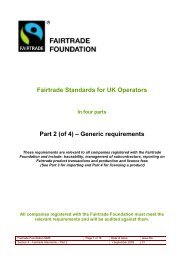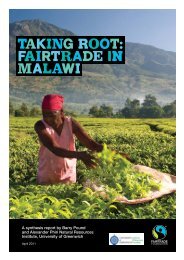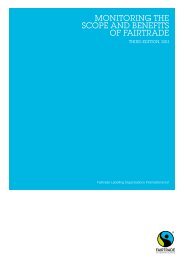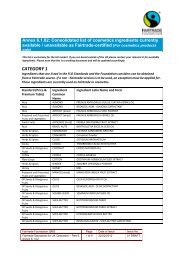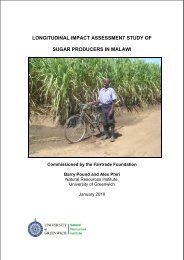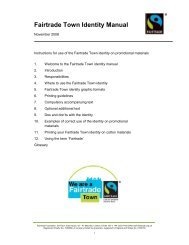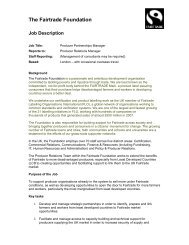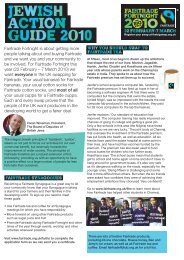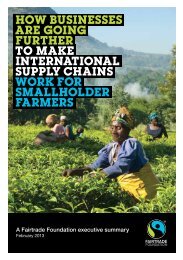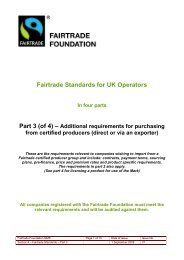the great cotton stitch-Up - The Fairtrade Foundation
the great cotton stitch-Up - The Fairtrade Foundation
the great cotton stitch-Up - The Fairtrade Foundation
Create successful ePaper yourself
Turn your PDF publications into a flip-book with our unique Google optimized e-Paper software.
THe EU: <strong>The</strong> highest<br />
subsidiser per<br />
pound of <strong>cotton</strong><br />
in <strong>the</strong> world<br />
‘<strong>The</strong> EU admits reducing<br />
its subsidies would help<br />
African producers and<br />
gain itself credibility,<br />
but continues paying<br />
out regardless.’<br />
Europe’s vital role<br />
US farm subsidies are <strong>the</strong> highest. But <strong>the</strong> European<br />
Union plays a small and significant role in keeping<br />
West African <strong>cotton</strong> farmers poor.<br />
Per pound of <strong>cotton</strong>, <strong>the</strong> EU hands out <strong>the</strong> largest<br />
amount of subsidies. <strong>The</strong> EU produces less than<br />
2% of <strong>the</strong> world’s <strong>cotton</strong>. <strong>The</strong> value of subsidies for<br />
this minimal production is low – $353m compared<br />
to $818m in <strong>the</strong> US in 2009/10 – but European<br />
farmers enjoy <strong>the</strong> highest subsidy per pound of<br />
<strong>cotton</strong>. <strong>The</strong> 2009/10 average assistance per<br />
pound produced in <strong>the</strong> EU was $2.51 compared<br />
to $0.14 in <strong>the</strong> US.<br />
Cotton subsidies in <strong>the</strong> EU began as part of <strong>the</strong><br />
Common Agricultural Policy (CAP) in 1981 when<br />
Greece was <strong>the</strong> first <strong>cotton</strong> producing country to<br />
join <strong>the</strong> <strong>the</strong>n European Community. Spain shortly<br />
followed into <strong>the</strong> EC, and today, <strong>cotton</strong> subsidies are<br />
distributed to around 100,000 producers in Europe:<br />
10,000 in Spain and 90,000 in Greece.<br />
A subsidy is given to <strong>cotton</strong> producers based on <strong>the</strong><br />
difference between <strong>the</strong> world price and a set support<br />
price. <strong>The</strong>re is a maximum guaranteed quantity of<br />
<strong>cotton</strong> that <strong>the</strong> subsidy will cover, and penalties apply<br />
for excess production. In addition to output subsidies,<br />
EU <strong>cotton</strong> producers also receive subsidies on inputs<br />
such as credit to invest in machinery, insurance and<br />
publicly financed irrigation.<br />
Some 65% of <strong>the</strong> aid to farmers has been ‘decoupled’<br />
from production, i.e. no longer linked to production<br />
and is paid to producers irrespective of <strong>the</strong>ir planting<br />
decisions. But critically, 35% remains in <strong>the</strong> form of a<br />
payment specific to <strong>cotton</strong> production. <strong>The</strong> European<br />
farmer is still paid for producing <strong>cotton</strong>. This coupled<br />
element has been kept to avoid abandonment of<br />
production in those <strong>cotton</strong> producing regions which<br />
typically lag behind in <strong>the</strong>ir economic development.<br />
Decoupling subsidies from production makes <strong>the</strong>m<br />
less trade distorting as priority is given to supporting<br />
<strong>the</strong> income of producers, ra<strong>the</strong>r than what <strong>the</strong>y<br />
produce. However, eliminating coupled subsidies<br />
all toge<strong>the</strong>r will have a positive impact on <strong>the</strong> C-4.<br />
It is estimated that had <strong>the</strong> 2006 CAP reform<br />
changes been implemented over <strong>the</strong> period 1998-<br />
2007 <strong>the</strong> world price of <strong>cotton</strong> would have<br />
increased by 0.7%. 17<br />
In a 2007 <strong>cotton</strong> impact assessment, <strong>the</strong> European<br />
Commission acknowledged that, ‘A fully decoupled<br />
support regime would be consistent with <strong>the</strong> EU’s<br />
negotiating position in <strong>the</strong> Doha Round’ made in <strong>the</strong><br />
WTO in 2006 to treat <strong>cotton</strong> ‘ambitiously, specifically<br />
and expeditiously’. Moreover, <strong>the</strong> impact assessment<br />
states that <strong>the</strong> ‘full decoupling option has <strong>the</strong> fur<strong>the</strong>r<br />
advantage of being in line with <strong>the</strong> reformed CAP,<br />
whose central element is <strong>the</strong> decoupling of<br />
income support.’ 18<br />
So why are <strong>cotton</strong> subsidies only partially decoupled?<br />
Holding back CAP reform and <strong>the</strong> fulfilment of <strong>the</strong> EU’s<br />
commitments in <strong>the</strong> WTO is a constitutional constraint<br />
which prevents <strong>the</strong> European Commission from fur<strong>the</strong>r<br />
decoupling aid.<br />
<strong>The</strong> European Community accession agreements for<br />
Greece and Spain stipulate that <strong>the</strong> EU must provide<br />
aid for <strong>cotton</strong> production, not just for <strong>cotton</strong> producers,<br />
because of <strong>the</strong> importance of <strong>cotton</strong> to <strong>the</strong> local<br />
economy. <strong>The</strong> 2007 impact assessment concludes that<br />
to avoid any real impact on production, decoupling<br />
must not exceed 65%. Meanwhile, <strong>the</strong> West African<br />
farmers are struggling to maintain <strong>cotton</strong> production<br />
on <strong>the</strong>ir own farms – <strong>the</strong>ir only source of income. <strong>The</strong><br />
opportunity presented by higher <strong>cotton</strong> prices remains<br />
out of reach for a farmer who cannot risk his livelihood<br />
on investing on such an uneven playing field. <strong>The</strong> C-4<br />
are trapped in limbo between an old and new Europe: one<br />
that will condemn, <strong>the</strong> o<strong>the</strong>r that will secure <strong>the</strong>ir future.<br />
<strong>The</strong> European Commission is aware of <strong>the</strong> inherent<br />
conflict between its <strong>cotton</strong> policy and its commitment<br />
to <strong>the</strong> development of <strong>the</strong> world’s poorest countries –<br />
<strong>cotton</strong> was highlighted in <strong>the</strong> 2007 Policy Coherence<br />
for Development Report as an issue where coherence<br />
between Development, Agriculture and Trade policies<br />
could be improved: ‘<strong>The</strong> EU continues to spend<br />
€800-€900m per year related to <strong>cotton</strong> farming, while<br />
<strong>the</strong> same product is grown in Africa at a lower cost<br />
supporting <strong>the</strong> livelihood of over 15 million people.<br />
<strong>The</strong> EU is not an important <strong>cotton</strong> producer globally.<br />
But by fur<strong>the</strong>r reducing its <strong>cotton</strong> production, <strong>the</strong><br />
EU would take a step that is likely to assist African<br />
producers. <strong>The</strong> EU would also gain in credibility in<br />
trade negotiations.’ 19<br />
Surprisingly, in <strong>the</strong> 2009 Policy Coherence for<br />
Development Report, <strong>the</strong> <strong>cotton</strong> issue is no longer<br />
pointed out as an area for policy coherence<br />
improvement but presented as a success for policy<br />
coherence: ‘Currently, total EU production is estimated<br />
at less than 1.3% of world production. Moreover, <strong>the</strong><br />
EU market is completely open and <strong>the</strong>re are no export<br />
subsidies. Fur<strong>the</strong>rmore, <strong>the</strong> EU supports <strong>the</strong> <strong>cotton</strong><br />
sector in Africa through <strong>the</strong> EU-Africa Partnership on<br />
Cotton which seeks to boost <strong>the</strong> competitiveness of<br />
African <strong>cotton</strong> and to lessen stakeholders’ vulnerability.<br />
<strong>The</strong> Commission and <strong>the</strong> EU Member States<br />
have supported this Partnership with projects and<br />
programmes of a value of more<br />
than €300m.’ 20<br />
<strong>The</strong> 2009 report focuses on progress made as well<br />
as assistance provided but fails to address <strong>the</strong><br />
discrepancy between most subsided agricultural<br />
products, which receive a 90% decoupled rate of<br />
support, and <strong>cotton</strong>, which only receives 65%.<br />
<strong>The</strong> European Commission seems to have simply<br />
decreased coherence expectations regarding <strong>cotton</strong>.<br />
By focusing on <strong>the</strong> €300m of aid, <strong>the</strong> European<br />
Commission is losing sight of <strong>the</strong> trade component of<br />
<strong>the</strong> deal, something warned against in <strong>the</strong> 2010 update<br />
relating to <strong>the</strong> EU-Africa Partnership on Cotton: ‘Aid<br />
cannot be considered a substitute for a commercial<br />
solution.’ 21<br />
‘<strong>The</strong> EU is aware of<br />
<strong>the</strong> conflict between<br />
its <strong>cotton</strong> subsidies<br />
and its commitment<br />
to <strong>the</strong> world’s<br />
poorest nations.’<br />
<strong>The</strong> EU’s <strong>cotton</strong> policy must be seen in <strong>the</strong> wider<br />
political context. All WTO members agreed in 2006<br />
to advance negotiations on <strong>cotton</strong>, and to date <strong>the</strong><br />
issue is held up as <strong>the</strong> ‘litmus test’ of development<br />
in <strong>the</strong> DDR. <strong>The</strong> EU has reformed its <strong>cotton</strong> policy<br />
and substantially decoupled <strong>the</strong> <strong>cotton</strong> subsidy from<br />
production. But so long as <strong>the</strong> EU maintains any trade<br />
distorting element to its <strong>cotton</strong> policy, its creditably in<br />
urging its trading partners, notably <strong>the</strong> US, to reform<br />
its <strong>cotton</strong> subsidies is severely undermined. While <strong>the</strong><br />
value of EU subsidies is dwarfed by <strong>the</strong> US subsidies,<br />
it remains <strong>the</strong> highest subsidiser of <strong>cotton</strong> per pound.<br />
<strong>The</strong> damage to <strong>the</strong> EU’s negotiating position when it<br />
comes to arguing for reform is immeasurable.<br />
<strong>The</strong> current CAP expires in 2013 and negotiations<br />
are underway for its reform. And <strong>the</strong> highly sensitive<br />
issue of <strong>cotton</strong> will not readily be addressed. To fulfil<br />
<strong>the</strong> commitments that <strong>the</strong> EU made in <strong>the</strong> WTO in<br />
2006 to treat <strong>cotton</strong> ‘ambitiously, specifically and<br />
expeditiously’, and to show commitment to concluding<br />
<strong>the</strong> DDR negotiations, <strong>the</strong> EU needs to act now to<br />
decouple <strong>cotton</strong> subsidies from production. This<br />
paper makes an urgent call for <strong>cotton</strong> to be addressed<br />
in <strong>the</strong> 2013 CAP reform.<br />
22 <strong>The</strong> <strong>great</strong> <strong>cotton</strong> <strong>stitch</strong>-up <strong>The</strong> <strong>great</strong> <strong>cotton</strong> <strong>stitch</strong>-up 23



